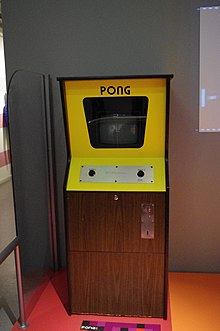Videogame
A video game, video game or video game is an electronic game in which one or more people interact by means of a controller, with a device that displays video images. This electronic device, known generically as a "platform", can be a computer, arcade machine, game console, or portable device such as a mobile phone, smartphone, or Tablet. The video game industry is one of the main ones in the world of art and entertainment.
The input device used to manipulate a video game is known as a controller or joystick, and it varies depending on the platform. For example, one controller might only consist of a button and a joystick or joystick, while another might feature a dozen buttons and one or more levers, which we call a controller. Early computer games often made use of a keyboard for interaction, or required the user to purchase a controller with at least one button. Many modern computer games allow or require the user to use a keyboard and mouse. simultaneously.
Generally, video games make use of other ways, apart from the image, to provide interactivity and information to the player. Audio is almost universal, using sound reproduction devices such as speakers and headphones. Another type of feedback is done through haptic peripherals that produce vibration or force feedback.
History
The origins of the video game go back to the 1950s, when shortly after the appearance of the first electronic computers after the end of World War II, the first attempts were made to implement programs of a ludic nature. Thus, Nimrod (1951) or Oxo (1952) were created, electronic games that still cannot be called video games, and Tennis for Two (1958) or Spacewar! (1962), true pioneers of the genre. All of them were still prototypes, very simple and experimental games that were never commercialized, among other things, because they worked on machines that were only available at universities or research institutes.
It would not be until the 70s when, with the decrease in manufacturing costs, the first arcade machines and the first video games aimed at the general public appeared. Titles such as Computer Space (1971) or Pong (1972), by Atari, inaugurated the first coin-operated arcade machines built for this purpose. Shortly after, video games would reach homes thanks to home consoles, the first of which was the Magnavox Odyssey (1972), and later the successful Atari 2600 or VCS (from 1977), with its interchangeable cartridge system. Around this time, arcade machines began to become common in bars and arcades, an expansion due in part to a hugely popular shooter, Space Invaders (1978). Other games that marked this early period were Galaxian (1979), Asteroids (1979) or Pac-Man (1980).
In the 1980s, the American company Atari had to share its dominance in the video game industry with two companies from Japan: Nintendo (with its famous NES console) and SEGA (with the Master System). At the same time, a generation of affordable personal computers with graphics capabilities arose that reached the homes of millions of families, such as the Spectrum, the Amstrad CPC, the Commodore 64 or the MSX. From then on, video games began to become a powerful industry. It was also a very creative time for video game developers; many of the main genres that exist today (driving, fighting, platforms, strategy, adventure...) took shape in this decade. On the other hand, the first pocket consoles also appeared, also known as "little machines", which, although until the arrival of the Nintendo Game Boy (1989) only played one game each, achieved great popularity among the youngest.
The 1990s brought the leap to 16-bit technology (such as the SNES and Mega Drive), which brought significant graphical improvements. The giant Sony enters the scene with its first PlayStation (1994), while Nintendo and Sega update their machines (Nintendo 64 and Sega Saturn). As for computers, the progress of PCs ends up wiping out all other systems except Apple's. More and more technologically advanced games appear, such as shooter games, also called 3D shooters. These started out in third person but through the implementation of first person camera techniques, they became what today is called First Person Shooter Games or FPS. In 2002 Microsoft entered the video console sector with its Xbox, in 2001 the Gamecube was launched and in 2006 Nintendo launched its innovative Wii. Meanwhile, Sony updates its successful PlayStation (versions II and III), and on PCs, thanks to the expansion of the Internet, online and multiplayer games take center stage.
Lastly, in the 2010s, portable touch devices such as smartphones and tablets emerged as gaming platforms, reaching a wide audience. On the other hand, several technology companies are beginning to develop virtual reality headsets, which promise to bring new experiences to the world of electronic entertainment.
General information
Typically, video games recreate virtual environments and situations in which the gamer can control one or more characters (or any other element of said environment), to achieve one or more objectives within certain rules.
Depending on the game, a game can be played by a single person against the machine, two or more people on the same machine, or multiple players over a LAN or online via the Internet, competing collaboratively against the machine or between Yeah.
There are many types of video games. Some of the most representative genres are action, role-playing, strategy, simulation, sports or adventure video games.
Technology
A video game is executed thanks to a software program (the video game itself) that is processed by a machine (the hardware ) that has input devices and output.
The software program or logical support contains all the information, instructions, images and audio that make up the video game. It is recorded on cartridges, optical discs, magnetic discs, special memory cards for video games, or it is downloaded directly to the device via the Internet.
In the 1980s, the usual support for software was the cartridge in game consoles, and the magnetic disk or cassette tape in computers. Later the CD-ROM was used, since it had more capacity than the cartridges since these had reached their technological limit and it was also cheaper to produce in mass. Currently, the high-capacity DVD system is used and, on desktop consoles such as PlayStation 4 and Xbox One, the very high-capacity Blu-Ray. However, for a few years downloading from the Internet has been growing, as it is a massively extended technology, easily accessible and less expensive than the physical distribution of discs, apart from the security advantages by avoiding losses due to damage or loss of discs (whether that the video game will be virtually always available).
Input devices are what allow the player to operate the game. Although it is common to use an external input device —such as the classic keyboard and mouse, the remote, or the joystick—, today's portable platforms (smartphones i>, tablets, pocket game consoles...) allow you to play via the touch screen or by moving the device itself (thanks to the use of gyroscopes and accelerometers). Other input devices can be motion detectors, including handheld devices (for example, the Wii Wiimote), pressure sensors (carpets or supports with sensors), virtual reality devices such as PlayStation VR and those for capturing images, in the case of the Xbox Kinect. The voice can also be used in those video games that support it through voice processors.
Output devices are those that display the images and sounds of the game: a television, monitor, or projector for video, and speakers or headphones for audio. The latest equipment uses Dolby Surround digital sound with EAX effects and modern visual effects using the latest technologies in game engines and graphics processing units.
The central piece of hardware is the CPU or central processing unit, which interprets the instructions contained in the programs and processes the data. Its processing capacity, greater in each new generation of devices, marks the limit of the technical and graphic possibilities of video games.
All these devices (input, output, processing...) can be physically separate units but connected to each other —as is the case of PCs or desktop game consoles—, or be integrated into a single device—such as mobile phones and other portable devices.
Platforms
The different types of devices that video games run on are known as platforms. The four most popular types of platforms are the PC, game consoles, handheld devices, and arcade machines.
Video game consoles or video game consoles are household electronic devices intended exclusively for playing video games. Created by various companies since the 1970s, they have generated a huge business of historical significance in the entertainment industry. The quintessential game console is a desktop device that connects to a television to display its images, but there are also pocket models with a screen included, known as portable game consoles.
The PC or personal computer is also a video game platform, but since its function is not only to play video games, it is not considered as a game console. The PC does not enter any generation, since every few months new parts come out that modify its benefits. The PC as a general rule can be much more powerful than any console on the market. The most powerful support graphic modes with resolutions and graphic post-processing effects far superior to any console.
Arcade video game machines are available in public amusement places, shopping malls, restaurants, bars, or specialized arcades. In the 1980s and 1990s they enjoyed a high degree of popularity as they were then the most technically advanced type of platform. Technological progress in home platforms has led to a certain decline in the use of machines at the beginning of the XXI century. arcade.
Handheld game consoles and other pocket-sized devices have the ability to play video games. Among the latter, mobile phones (particularly smartphones) stand out today, which, without being video games their primary function, have been incorporating them as their technical features have increased. Other portable devices that have grown in popularity in recent years are tablets.
Genres
Videogames can be classified into genres based on factors such as the game system, the type of interactivity with the player, their objectives, etc. The evolution of video games since its inception has given rise to a growing and changing variety of genres, often in relation to what advances in technology have made possible. Among the most popular video game genres are those of action, strategy, role-playing, adventure, puzzle, simulation, sports or racing, each of them with several subgenres. On the other hand, nowadays video games that take elements from more than one genre are common, which has given rise to mixed genres (for example role-playing, action-adventure, etc.).
Along with genres, there are other ways to classify or characterize games such as their theme (fantastic-medieval, futuristic, war...), their complexity (AAA games, casual games...), its purpose (educational, promotional, artistic...), type of development, etc.
On the other hand, some games are also distinguished from others, even within the same genre, by the visual perspective they adopt (or in other words, the position of the camera). Thus, there are games with 2D perspective (either with parallel projection, side view or top view), 2.5D (using isometric projection, oblique, or parallax scrolling, among others), and 3D (in fixed perspective, in first person, or in third person).
Multiplayer
In many games you can find the multiplayer option, that is, that several people can participate simultaneously in the same game, either using the same machine (as usually happens with video consoles) or each using their own device (the usual case in PCs or portable devices, in what is known as online video games). There are games in which a human player faces off against other players controlled by the machine, using artificial intelligence, but in this case it is not considered to be a multiplayer video game. Finally, there are video games that are designed to bring together a large number of players from all over the world connected through the Internet, they are known as MMO video games (from massive multiplayer online).
Video game industry
Born with the appearance of the first coin-operated arcade machine in 1971, in a few decades the video game industry has gone from being a mere technological curiosity to becoming one of the largest entertainment industries by turnover. It is estimated at 1 dollar in 2014 worldwide, reaching double that of the film industry in the same year. Revenues come mainly from the sale of video games, video consoles, accessories and recreational machines. The top countries for video game revenue are the US, China and Japan, followed by Germany and the UK. Spain is in tenth position, billing nearly 1,500,000,000 dollars annually.
The video game industry employs more than 100,000 people around the world, people from many different disciplines including programming, design, engineering, performance, finance, marketing, music, communication or trade. The value chain in the video game industry can be divided into 6 parts: investors, video game developers, creators of the software used by developers, hardware manufacturers, video game distributors, and consumers.
Development costs for a commercial game vary wildly from as little as a few thousand dollars for a small title, developed by one person, to more than $100,000,000 for some AAA games, involving teams of up to a hundred workers. The game with the highest development cost to date is Grand Theft Auto V, from developer Rockstar Games, with $167 million, followed by Destiny, from Bungie, with 154 million dollars. The figures are even much higher if the investment in marketing is added.
Video game fairs are one of the main showcases where the industry presents its most recent creations every year. The best known worldwide are E3 in Los Angeles (USA), Gamescom in Cologne (Germany) and Tokyo Games Show (Japan). In France the most important fair is Paris Games Week and in Spain Madrid Games Week, GameLab and GameFest stand out. In Chile, the Festigame stands out above all, being the most important in Latin America. Consumers find out about the latest developments in the sector mainly through specialized media. Among those belonging to the Hispanic sphere, we can highlight print magazines such as Micromanía, New Superjuegos or Hobbyconsolas, and Internet magazines such as Meristation, Vandal, Eurogamer, Gamercafe, LagZero or Niubie. There are also numerous blogs and YouTube channels focused on this topic. However, its presence on television or radio is less.
The sale of video games has traditionally been carried out in department stores or specialized physical stores; In Spain, the two main video game store chains are Game and, until it closed in 2014, Gamestop. In Chile, the largest are Zmart, MicroPlay and TodoJuegos. However, the trend in recent years around the world is towards internet sales via download, both on PC and consoles. On mobile devices, selling online —through app stores— is in fact the only channel available.
The main industry associations in Spain are AEVI (Spanish Video Game Association), which includes companies that invoice 90% of the total revenue of the sector, and DEV (Spanish Video Game Development), which brings together the main developer companies from the country. In Chile there is the VGChile group, where Chilean developers are grouped.
Some of the most important international video game developers are: Blizzard Entertainment, Valve, Rockstar North, Bungie, Microsoft, Nintendo, BioWare, Sega, Sierra Entertainment or Zynga, to which we must add internal studios (some often namesakes) from the main distributors.
Indie Video Games
In a market dominated by the large video game distributors, it is worth noting in the last decade the rise of independent video games (also known as indie), which have come to constitute their own section in stores and on distribution platforms such as Steam or Gameloft. These games are developed by small groups of no more than 20 people, without the financial help of any distributor. They are usually characterized by a varied and particular artistic development, both in graphics and in soundtrack, with stories with innovative plots and that generally do not have a continuity or are not designed to create a saga. The originality of his approaches, often moving away from established stereotypes, has earned him the interest of a part of the fans.
Game development
The creation of video games is an activity carried out by video game developers. These are in charge of designing and programming the video game, from the initial concept to the video game in its final version. This is a multidisciplinary activity, which involves professionals from computer science, design, sound, acting, etc. The process is similar to creating software in general, although it differs in the large amount of creative input (music, story, character design, levels, etc.) required. The development also varies depending on the target platform (PC, mobile, consoles), the genre (real time strategy, RPG, point and click adventure, platforms, etc.) and the way of visualization (2d, 2.5d and 3d).
The commercialization of the games created by the developers is the work of the video game distributors. These are in charge of its distribution (whether through physical stores or online), advertising, presentation, translation... but they also often play a fundamental role before and during the development of the game, such as its conception, its financing, market studies, quality control, etc. Many distributors have one or several own development studios, regardless of whether or not they can work with external developers.
Gaming
The science that studies video games is called "gaming" or the study of games. One of the main aspects studied by this science and the information it collects are the positive and negative impacts of video games on people. This science deals with the critical study of games, their design, the players and the interaction between the two, as well as their role in society and culture. The methods used to collect data range from surveys and ethnographic research to controlled laboratory experiments.[citation needed]
Social impact
Demographics
An online survey conducted by ISFE among Europeans aged 16-64 revealed that 48% of them play video games, either regularly (1 or more times per week, 25%) or occasionally (23%). In Spain, this percentage would be 40%, and in the US (according to the ESA) it would be 59%. By age, 51% of European gamers are under 35 years of age and 49% older, with an average age of 34 years (the study carried out in the US places it at 31 years). By gender, 55% are men, 45% women. According to a 2015 study, the data in the US changes; 50% of men play video games while 48% of women do; of these, only 15% of men would be called Gamers against 6% in women.[1]
It should be noted that the demographics of video games have not always been the same. In the past, video games were a type of entertainment almost exclusively for young people, but this situation has changed over the years, as various recent studies show. In addition to those already mentioned, a study by Parra, David et al. (2009), in which 974 surveys were carried out among Spaniards over 35 years of age, concluded that "video games are being implemented with singular intensity in the Spanish population as a whole. More than half of Spaniards over the age of 35 (53.5 percent) play video games (either sporadically or regularly)".
Psychological effects
The effects that habitual use of video games may have on people, and especially on children, have been the subject of interest and controversy.
Among the positive effects attributed to them are capacities such as: «hand-eye coordination, logical capacity, spatial capacity, problem solving, strategy development, concentration, attention, collaboration, cooperation and selection of relevant information, stimulation auditory, among others." According to a study, the child develops mental abilities and his reasoning ability is more active compared to a child of 20 years ago who did not have this technology. In adults they can work as a stress reliever, contributing to good health. Others claim that they improve visual health and even certain skills such as those necessary for the practice of surgery. It should also be noted that the effects vary according to the type of play. A professor at the University of Nottingham has also claimed that they may have the effect of reducing pain. According to a study, short-term exposure has a positive effect on attention in children without psychiatric problems, they scored better on the Stroop test after being exposed to a video game they played for the first time for an hour.
As for the negative aspects of video games, it is worth noting factors such as addiction. Easy access to computers, smartphones and game consoles, coupled with a lack of parental control or a dysfunctional home environment, can lead children or adolescents to make abusive use of the video game. This has negative effects such as being more prone to aggressiveness, lack of assertiveness and low academic performance.
Another controversial aspect of video games in children is that they can slow down some aspects of their motor development, and lead to a lack of socialization, although the latter is refuted by other studies that point to the opposite, that video games videogames increase their sociability. "Videogames are entertainment that is well suited to the reality of the child born in the computer age, since they involve socialization in the simulation culture that characterizes contemporary advanced societies” (Turkle 1997).
In a study linking mental health and playing video games, it was found that gamers who played moderately had the best mental health, those who played excessively had a slight increase in problem behaviors, and those who did not play video games they had the worst mental health.
Scientific studies show that, in general, video games enrich the life of the player, teach them to solve technical problems, and stimulate their neuro-kinetic abilities, visual reflexes and focus of multiple points of vision (objectives). They even improve communication when playing as a family or online.
As educational tools
In some schools some videogames have been implemented in order to expand the didactic methodology and make the classes more enjoyable.[2] Various experts have pointed out the value of video games as tools to instill knowledge. Gros, B. and his collaborators (1997) write: «We think that computer games constitute a computer material of great pedagogical value», and list a series of characteristics:
- These are materials with a very high motivational capacity.
- They improve the procedural aspects of the work of students.
- They are very flexible since they can be used in different subjects and in a transversal way.
- They provide elements to improve student self-esteem.
- It is a material available to both students and teachers.
Educational games have recently been presented as an alternative to violent video games. There is even a collection of games whose cover art reads "the smart alternative to violent video games".
Despite the positives, all the negatives should be taken into account, such as unlimited and unsupervised use, as well as a lack of commitment, responsibility or effort with activities that are not related to gambling. For this reason, the ideal is not to lose sight of the fact that although videogames are based on entertainment, they are used as tools to enable or potentiate learning, which will be achieved as long as there is good use and control by the users or those responsible for these.
Gee (2004) states that "the learning theory embodied in good video games is closest to what I believe are the best learning theories put forward by cognitive science." In this way, he establishes a similarity between the learning theories that are used daily in the educational field with the theories incorporated in video games, finding between them few points in which they diverge.
Criticism
Videogames, like other forms of audiovisual expression, have aroused controversy among people or groups who consider that they have or may have harmful effects on players. Among these are argued, for example, the effects that spending too much time in front of the screen and being completely inhibited in a fantasy universe can have on emotional development. There are also cases of compulsive gambling and cyber addiction. A possible promotion of violence and lust, graphically present in many video games, is also argued. On the other hand, it has been proven that the speed with which the graphs move can provoke seizures in people who suffer from various types of epilepsy.
Influence on academic performance
Different studies with children and adolescents (Castells & Bofarull, 2002; Bringas, Rodríguez & Herrero, 2008) show that school performance can be affected by the use of video games. However, there are different articles that establish that moderate levels of play are not associated with poor school performance (Ferguson, 2011); they could even be related to better performance (Llorca, Bueno, Villar & Díez, 2010). This it is because gamers who use video games acquire better knowledge strategies, problem solving strategies, and their spatial abilities, their precision and reaction capacity are gradually improved (McFarlane, 2002).
Legal aspects in Spain
In Spain, the impossibility of registering the video game as such, is due to the fact that it is not legally recognized because it is not contemplated in the framework of article 145.1 of Royal Legislative Decree 1/1996, of April 12 (hereinafter, Law of Intellectual Property or LPI), as an original and unitary intellectual creation, obliges its creators and owners to desist from registering it as a video game, having to separate each work according to its own artistic, scientific or literary nature, which is evidence as an obstacle in the absence of a specific regulation that allows the industry to protect, export and internationalize these intangible assets in constant socioeconomic growth, under a stable legal framework in the field of intellectual property of their creators.
In 2009, the "Proposition No Law (PNL)" of the Congress of Deputies was unanimously approved with two amendments from the Popular Party and CiU: "The Culture Commission of the Congress of Deputies establishes that the video game constitutes a fundamental area of creation and the cultural industry in Spain. Consequently, it urges the Government to recognize its creators and entrepreneurs as protagonists of our culture. Likewise, within the framework of its powers and in coordination with the competent regional administrations, the Government is urged to facilitate its access to all feasible aid for the promotion of its activity, financing as a cultural industry and the internationalization of its initiatives.
The most relevant thing about NLP is that it is unanimously agreed that "it should not be valid to consider them as audiovisual work and, on the other hand, they should not be assimilated simply to creators of software ".
Contenido relacionado
KDE
Gary Kildall
Radio (media)









